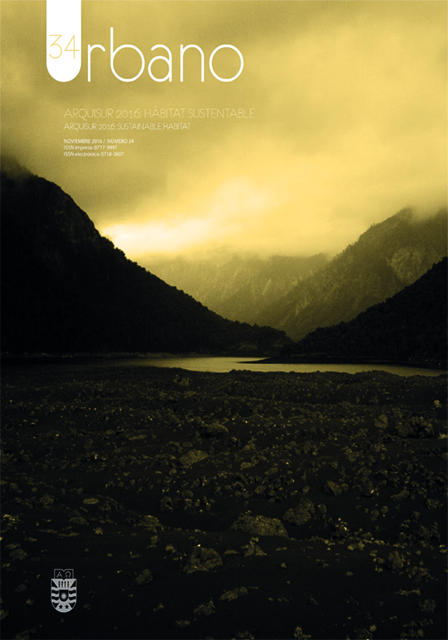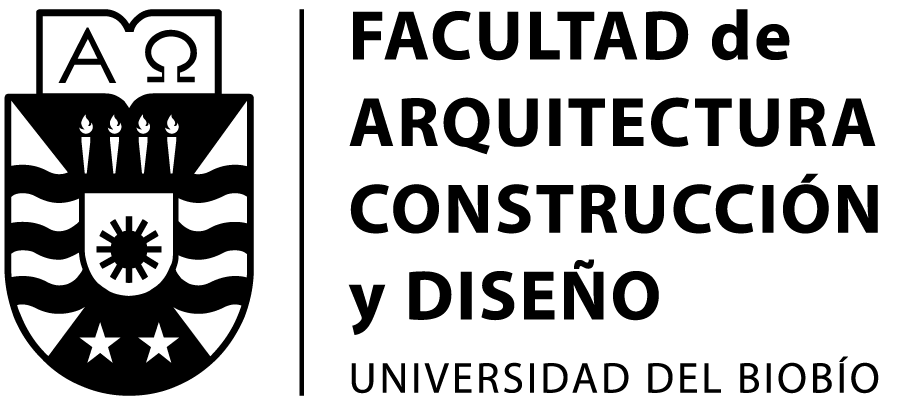Sky view factor and the heat island effect in Valparaiso
Keywords:
heat island, climate, urban morphology, urban fabric, urban planningAbstract
Urban form transforms territory and its climatic behavior. The morphology of a city varies from its centers to its periphery, as do population density, the temporal use of buildings, the presence or absence of vegetation and transport density. These variables condition the thermal behavior of public spaces. Sky View Factor (SVF) is defined by taking into account sky visibility from an urban canyon, which is related to the thermal storage and ventilation of street space. Both variables are key to pedestrian comfort and city warming. This paper presents climate performance data associated with the morphology of the city of Valparaíso, which has a coastal Mediterranean climate. Simultaneous climate measurements were taken in different parts of the city. These were then correlated with the geometric and material parameters of the locations studied. A close relationship was found between urban morphology, the thermal behavior of public spaces and an increased temperature favoring the urban heat island phenomenon (UHI). This data would make it possible to more accurately predict street level climate conditions and how they affect the UHI.
Downloads
References
Akbari, H., & Konopacki, S. (2005). Calculating energy-saving potentials of heat-island reduction strategies. Energy Policy, 33(6), 721–756.
Ali-Toudert F. & Mayer H., Numerical study on the effects of aspect ratio and solar orientation on outdoor thermal comfort in hot and dry climate, Building and Environment, 41 (2006), pp. 94–108.
Ashtiani, A.; Mirzaei, P. A. & Haghighat, F. (2014), Indoor thermal condition in urban heat island: Comparison of the artificial neural network and regression methods prediction, Energy and Buildings 7, 597-604.
Blennow, K. (1995) Sky view factors from high resolution scanned fish-eye lens photographic negatives. Journal of Atmospheric and Oceanic Technology 12. pp1357-1362.
Bozonnet E., R. Belarbi and F. Allard, (2006) Modelling air flows around buildings in urban environment, International Workshop on EPEQUBE, Milos Island, Greece, July, 2006.
Brewer-Carías Allan R. La ciudad ordenada. Instituto Pascal Madoz. Universidad Carlos III. Boletin Oficial del Estado. Madrid 1997.
Busato F, Lazzarin R.M. & Noro M. (2014) Three years of study of the Urban Heat Island in Padua: Experimental results. Department of Management and Engineering, University of Padova, Sustainable Cities and Society, 10, 251–258.
Carrasco C. (2014) Analysis of urban heat island and its effects in Valparaíso, Chile. Presentado en la conferencia IC2UHI, Venecia, diciembre 2014.
Cleugh, H.A. & Oke, T.R. (1986). “Suburban-rural energy balance comparisons in summer for Vancouver, B.C.”. Boundary Layer Meteorology, 36, pp. 351-369.
Christen A., Vogt R., Rotach M.W., Parlow E. (2002a). First Results from BUBBLE I: Profiles of fluxes in the urban roughness sublayer. AMS 4th Symposium on the Urban Environment, Norfolk VA. 105-106.
Christen A., Vogt R., Rotach M.W., Parlow E. (2002b). First Results from BUBBLE II: Partitioning of turbulent heat fluxes over urban surfaces. AMS 4th Symposium on the Urban Environment, Norfolk VA. 137-138.
Davis R. E., Knappenberger P. C., Michaels P. J. & Novicoff W. M. Wave mortality in large U.S. cities. Fifth Conference on Urban Environment. Vancouver, BC. August 2004.
Gal T., Lindberg F. & Unger1 J. (2009) Computing continuous sky view factors using 3D urban raster and vector databases: comparison and application to urban climate. Theoretical and Applied Climatology. 95: 111–123.
Grimmond C.S.B., Potter S.K., Zutter H.N. & Souch C. (2001) Rapid methods to estimate sky- view factors applied to urban areas. International Journal of Climatology 21: 903–913.
Grimmond C. S. B. & Oke, T. R., (1999) Heat storage in urban areas: observations and evaluation of a simple model, Journal of Applied Meteorology 38 pp. 922-940.
Grimmond C. S. B. & Oke, T. R. Comparison of heat fluxes from summertime observations in the suburbs of tour Nort American cities. Journal of Applied Meteorology (1995) Vol. 34, pp. 873-889.
Isalgué, A. Roset J. & Coch, H.. Environmental Evaluation of an Urban Sector. REBUILD: The European Cities of Tomorrow - Shaping our European Cities for the 21st Century. Butera, et al (ed.), ETA-Florence, 1998.
Kikegawa Y., Ohashi Y. & Kondo H. Observed and simulated effects of urban canopy on air temperatures in summer Tokyo. 7th Conference on Urban Environment. San Diego, CA. September 2007.
Kolokotronia M., Rena X., Daviesb M., Mavrogianni A. (2012) London’s urban heat island: Impact on current and future energy consumption in office buildings. Energy and Buildings 47, 302–311.
Ratti C., Baker N. & Steemers K. Energy consumption and urban texture. Energy and Buildings Vol 37. pp. 762 - 776 (2005).
Roth, M. & Oke T.R., (1995) Relative efficiencies of turbulent transfer of heat, mass and momentum over a patchy urban surface. Journal of the Atmospheric Sciences, 52, 1863-1874.
Santamouris, M., Argirious, A. & Papanikolaou, N. (1996). Meteorological Stations for Microclimatic Measurements. Report en Proyecto POLIS. Comisión Unión Europea, 1996.
Souza, L. C. L.; Rodrigues, D.; Mendes, G. & J. F. A 3D-gis extension for sky view factors assesment in urban environment. In: CUPUM 2003 - 8th International Conference on Computers in Urban Planning and Urban Management, 2003, Sendai. CUPUM'03 Sendai, 2003.
Susca, T., Gaffin, S. R., & Dell’Osso, G. R. (2011). Positive effects of vegetation:Urban heat island and green roofs. Environmental Pollution, 159(8–9), 2119–2126.
Takebayashi, H., & Masakazu, M. (2007). Surface heat budget on green roof and highreflection roof for mitigation of urban heat island. Buildings and Environment,42 (8), 2971–2979.
United Nations. (2010). World urbanization prospects: The 2014 revision population database. https://esa.un.org/unpd/wup/
Voogt J. A. & Krayenhoff E. S.. Modeling urban thermal anisotropy. International Society OF Photogrammetry and Remote Sensing. Proceedings of the ISPRS joint conference. Tempe, AZ, USA, March 14-16 2005.
Downloads
Published
How to Cite
Issue
Section
License
The content of articles which are published in each edition of Habitat Sustentable, is the exclusive responsibility of the author(s) and does not necessarily represent the thinking or compromise the opinion of University of the Bio-Bio.
The author(s) conserve their copyright and guarantee to the journal, the right of first publication of their work. This will simultaneously be subject to the Creative Commons Recognition License CC BY-SA, which allows others to share-copy, transform or create new materials from this work for non-commercial purposes, as long as they recognize authorship and the first publication in this journal, and its new creations are under a license with the same terms.![]()























